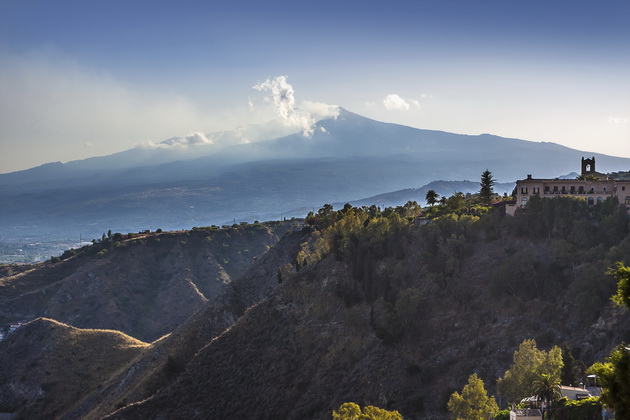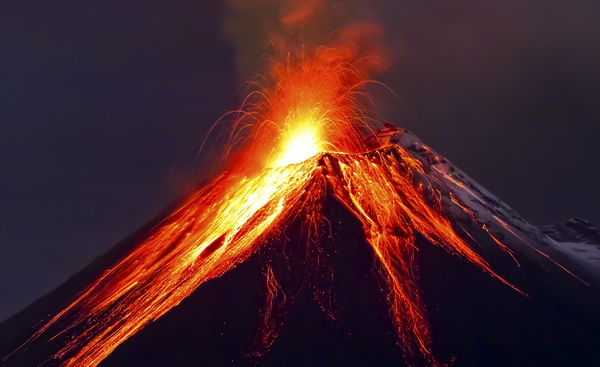 Editor’s Note: I’ve been writing about volcanic wines since my second book, Unquenchable, was published with Random House in 2011. My fascination with them continues.
Editor’s Note: I’ve been writing about volcanic wines since my second book, Unquenchable, was published with Random House in 2011. My fascination with them continues.
I expected something a little more dramatic: the sizzle of a lava river oozing down the volcano, the rumble of the earth as it split between my feet, the screams of villagers running for their lives.
Instead, all I hear are the clicks of tourist cameras as we look up at Mount Etna, its white tip puffing peacefully against the blue sky.
“To have seen Italy without having seen Sicily is not to have seen Italy at all,” Goethe wrote. “For Sicily is the clue to everything.”
That’s why I’m here on this island of dazzling sunshine and menacing shadows, with its barely controlled wilderness and passionate personalities. I’ve heard that the people here have fiery tempers, forming friendships over lunch and falling out by dinner.
No one does vendettas like the Sicilians.
I like my wines with a little hell-fire in them; volcanic viticulture fascinates me. Making wine from water is so BCE, but making wine from lava—now that fires the imagination.
I also believe that just as Sicily is the clue to Italy, today’s winemaking unlocks the country’s vinous past. The ancient Greeks believed that Sicily was the birthplace of wine.
 One of their legends describes the journey that Bacchus made from Mount Olympus to the island, carrying a tiny vine in a hollowed out bird bone.
One of their legends describes the journey that Bacchus made from Mount Olympus to the island, carrying a tiny vine in a hollowed out bird bone.
As he travelled, the plant kept growing, so he moved it to a lion’s bone and then into a donkey’s bone. When he got to Sicily, he planted the vine; and from the grapes it bore, he made the world’s first wine. The symbolic message is that a little wine will make you as light as a bird; a little more will make you as brave as a lion; and a lot more will make you as dumb as an ass.
The Greeks called Sicily “Oenotria,” meaning Land of Vines from the Greek oinos for wine. The Athenians invaded the island in 415 BCE, according to the historian Thucydides in his History of the Peloponnesian Wars, determined to spread Hellenic culture and government.
Greek city states such as Siracusa (Syracuse) had been long established on Sicily, along with the cultivation of grapevines. Homer described Sicilian vineyards as “watered by Zeus, yielding wine of strength in which ambrosia and nectar flowed in abundance.”
Odysseus used that robust local wine to intoxicate the Cyclops, so that he and his crew could escape from the island. The boulders strewn along the coastline are supposedly the ones that the Cyclops hurled after the departing ship.
By 404 BCE, the Spartans and Persians had helped the Sicilians to oust the Athenians; and they in turn were ousted by the Romans, who were eventually kicked out themselves by the locals.
The island’s strategic position in the middle of the Mediterranean meant that someone was usually invading it. You can see the successive conquering influences in the architecture of the capital city, Palermo: a Greek temple, a Norman church, a Roman theatre, a Moorish roof-line, Arab flourishes on a balcony and window, a Bourbon archway.
Stairs between buildings tilt right and left like a game of snakes and ladders. The markets feel ancient and mysterious, bustling with colorful people and produce but edged with dark, shadowed alleyways. Palermo is an open-air museum: a boisterous blend of narrow streets, piazzas lined with multi-coloured mosaic tiles, fashionable wine bars and bistros, grand opera houses and soaring cathedrals.
On this 16,000-square-mile island, a tiny football a mile off the toe of mainland Italy, there are about three hundred thousand acres under vine, more than in Bordeaux and Chile combined.
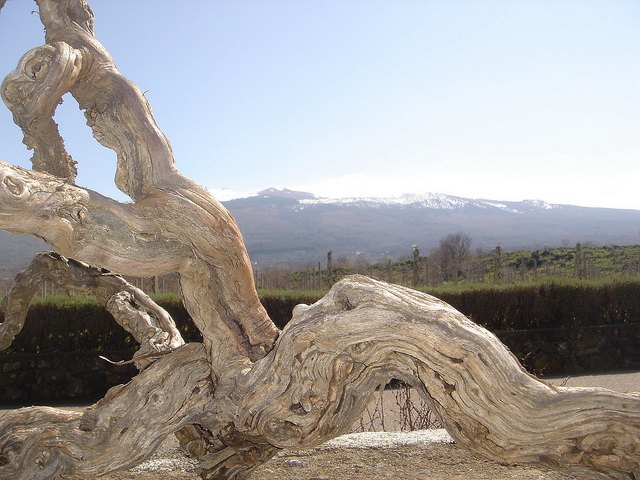 Ancient Nero d’Avolo vine and Entna in the background
Ancient Nero d’Avolo vine and Entna in the background
It produces 185 million gallons a year, more than all of Australia. If Sicily were a country, it would be the fifth-largest wine producer in the world. Producers here refer to the island as a continent of wine for both its production and diversity.
As one of the world’s oldest and youngest winemaking regions, Sicily is trying to resolve that conflict between ancient local traditions and modern international style. For years, southern vintners had no incentive to make fine wine for export.
Grape prices were so low that producers earned more money making workhorse wines for local consumption and low-end export. Most wine made here was sold by the tanker-load to beef up prestigious, but anemic wines in northern Italy and in France—where it was often delivered to the estates’ back entrances at night.
Sicily also has a cultural divide with the rest of Italy, especially the north that produces some of the most beautifully designed clothing, cars, and wine in the world.
The brand names roll luxuriously off a consumption-loving tongue: Ferrari, Ferragamo, Tignanello. In fact, few countries have such a contrast between an industrious north with its sleek fashions, fast cars and 4 percent unemployment; and a languid, lawless south with its agrarian focus, slower pace and 20 percent joblessness.
There’s even a divide between southern Italy and Sicily. The islanders refuse to build a bridge to the mainland just a mile away, even though it would help with commerce and tourism. No wonder Sicilians are often considered the most Italian of Italians: fierce, loyal, stubborn, passionate.
That divide in Italian culture extends to winemaking, which the rest of the world has long perceived as either cheap and cheerful, or else costly and confusing.
Think of those squat, straw-wrapped chianti bottles (candle is optional) that epitomized the sixties and seventies. Now think of the sleek, gold-embossed labels of Super Tuscans, such as Sassicaia and Tignanello, that represented the greed-is-good eighties and nineties. There’s never been much of a middle ground for consumers who just want good quality, reasonably priced Italian wines.
However, since the 1980s, the market for low-end wines has been drying up. The only way Sicilian producers could survive was to improve quality. And frankly, there was plenty of room for improvement.
Unfortunately even today, Sicily’s best-known wine is also its worst-regarded: marsala, a fortified dessert wine. Historically, it was hard to swallow, with its oxidized, burnt flavors.
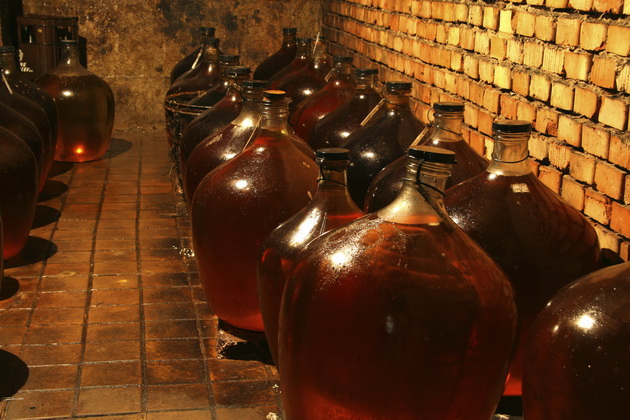 In 1773, when the British merchant John Woodhouse (stranded on Sicily for several days during a storm) tasted the wine at a local tavern, he realized that it would keep on a long sea journey if it were fortified with brandy.
In 1773, when the British merchant John Woodhouse (stranded on Sicily for several days during a storm) tasted the wine at a local tavern, he realized that it would keep on a long sea journey if it were fortified with brandy.
Marsala eventually replaced port as the British sailor’s drink of choice, Nelson’s navy drank it up, and Woodhouse retired a rich and groggily happy man.
Marsala is still unfairly tagged as plonk. This wine has the potential to be a divine after-dinner drink—a fact foreseen perhaps by the Arabs, who originally named the town Marsa el Allah, meaning “port of God.”
It’s a mystical watery world between land and sea on the island’s western shore, where the setting sun plays off the salt flats, sending shafts of red and purple light up through the clouds.
Like sherry, marsala uses the solera method of aging: wine from the current vintage goes into the first barrel and is gradually siphoned from one barrel to another, year after year.
Wine from the last barrel is drawn off to be consumed and that barrel is then topped up with wine from the second-oldest. This fractional blending preserves the flavor signature of the wine over years because, in theory, a little wine from the first vintage, and from all others since then, is in every bottle.
However, in the 1940s, marsala fell from grace, no longer suiting the taste of the times. Shoddy winemaking, such as adding egg yolks, almonds and other unmentionable ingredients, hastened its demise.
This syrupy wine was relegated to cooking sauces, no longer considered a digestif like port or brandy. Soon most Sicilian wines were described as marmalata because they were so jammy-overripe—hardly surprising when temperatures in Sicily can soar to 46oC 115oF during the harvest.
Even though Sicilian winemaking has improved considerably over the past decade, marsala’s former image still sticks to it. Poorly made wines are like a crime-ridden neighborhood, tarnishing the reputation of an entire city.
However, marsala is worth trying. It’s graded according to color, sugar, alcoholic strength, and length of aging. The best types are Vergine (five years aging) and Stravecchio (ten years). Some of the most reputable producers today include Florio, De Bortoli, Martinez, and Lombardo.
One of my favourite Italian authors is Giuseppe Tomasi di Lampedusa, whose brilliant novel The Leopard chronicled the decline of the nineteenth-century aristocracy in Sicily.
The author could have been describing the local wine industry when he observed: “If things are to stay as they are, then something has to change.”
The setting of his book is now a winery called Donnafugata, meaning “fugitive woman.” It was named for Queen Maria Carolina of Naples, who fled to the estate when Napoleon’s army invaded her city at the end of the eighteenth century.
My favorite wine from Donnafugata also has a romantic, windswept name: Mille e Una Notte—a thousand and one nights.
When the market for marsala collapsed in the 1960s, the local government created winemaking co-operatives that bought eighty percent of the harvest, mostly from small farmers. These co-ops still exist; the largest, Settesoli, is now the size of an oil refinery, capable of crushing more than 110 million tons of grapes.
The company occupies much of the village of Menfi on the western shore, employs more than 20,000 people, and owns more than five percent of the island’s vineyards.
By the late 1980s, the market for bulk wine started to tank as well. Europe had become a wine lake, producing much more than it could drink or distill into spirits such as vermouth or even turn into ethanol for automobiles.
Government subsidies dried up and the big co-ops had to change their strategy. One of the most prescient executives was Diego Planeta, president of Settesoli, who started the drive to improve quality.
With the help of oenologist Giacomo Tachis, who had just retired from the respected Super Tuscan winery Sassicaia, Diego planted experimental vineyards with a wide variety of grapes to determine which best suited Sicily’s climate and soils.
The winner? Nero d’avola, the black (nero) grape from the town of Avola in eastern Sicily. Apart from small plantings in Calabria, on the toe of the mainland, it’s only grown in Sicily today.
Nero d’avola produces a wine packed with distinctive flavor, reminding me of the quirky Italian actor Roberto Benigni in Life is Beautiful. This inky wine with a tight-wire streak of acidity is as plush and quaffable as merlot, but it also has the darker, peppered-violet character of syrah.
It shares the chameleon nature of Tuscany’s sangiovese grape, which makes chianti such a round, generous wine, but becomes austere and structured in brunello di montalcino. It’s a perfect complement to our Thursday night pasta meals.
Even within Sicily, the style of nero d’avola varies according to climate and soil. It can be spicy and taut like Rhone syrah in the limestone soils near Noto, or fleshy and fruity like Australian shiraz in the clay soils near Menfi.
The thin-skinned, late-ripening grape is susceptible to rot, like merlot, and so it thrives in Sicily’s hot, dry climate. The island is on the same latitude as Tunis, North Africa, and gets an average of 130 days of sunshine a year.
A hot, stinging, sand-laden wind called the scirocco often blows north across the Mediterranean from the Sahara Desert, sometimes reaching hurricane speeds of eighty miles an hour. It ripples the horizon, whips up dust clouds, burns off excess moisture. The few raindrops that fall on Sicily acquire a sandy coating before reaching the earth.
Working a Mediterranean vineyard means tending a scorched garden under an apocalyptic sun. Until the sun sets, that is. Of evenings on the Sicilian coastline, Colombian novelist Gabriel García Márquez wrote that “the sea on windless nights reflects the beams of African lighthouses, while on the bottom of the sea lies a sleeping wine amphora.”
When it comes to winemaking, nero d’avola is best when yields are kept low to focus the vine’s nutrients in fewer grapes, which produces more concentrated flavours.
It likes a slow, temperature-controlled maceration and fermentation to extract more flavor, color and tannin compounds from the grape skins and seeds. These compounds give it structure, balance and the ability to age.
It also has the ability to blend: nero d’avola is a grape swinger, mating easily with merlot, cabernet sauvignon, syrah and the local red grape frappato. On its own or blended, it’s a wine with a robust love of flavor that’s not heavy, making it an excellent house wine: it’s charm-on-the-cheap.
Like most Italian wines, nero d’avola has a vibrant acidity that makes it taste fresh and clean. This helps it to pair well with the savory profusion of Sicilian food. The island’s rustic cuisine is complemented by the flavors of many cultures: capers, olives, garlic, peppers, mint, fennel, almonds, raisins, citrus and dried herbs.
The Arabs introduced spices, mint, fennel, saffron, eggplant, almonds, lemons, limes, oranges, raisins, capers, pine nuts, anchovies, pasta, pastries and couscous (which they adapted to make a dish based on fish rather than lamb). The Greeks made honey, olive oil and wine; the Romans grew wheat, vines and beans; the Normans brought salt cod; the Spanish made rich tomato sauces.
The food and wine here speak of history, terrain, identity and people. You can devour Sicily’s history on your plate.
The white wine grape that thrived in Diego’s Planeta vineyards was insolia, a grape also known as inzolia or ansonica. It’s the backbone of marsala, which never helped the grape’s reputation. But by keeping yields down and using temperature-controlled fermentation, insolia produces a wine that’s a wonderful jumble of white peach, mango, lime zest and coconut sliver aromas.
It reminds me of excellent dry riesling, and makes my mouth water to think how well it would go with the island’s seafood, especially fresh grilled swordfish with olives, tomatoes and capers.
Diego was impressed with the results of his vineyard experiments, which included clonal selection, trellising and irrigation methods. (Sicilian wine regulations forbid irrigation, except by an emergency ruling; but there seems to be an emergency every year.)
In 1995, he started his own boutique winery, Planeta, on the hillside village of Sambuca di Sicilia. Planeta’s flagship nero d’avola, Santa Cecilia, is a heady aroma cloud of blackberries, sage, and dark chocolate. A potent core of dark fleshy flavors roll over your tongue, finishing with a blast of black raspberries and anise.
Dare I liken it to the smoldering, dark bride in The Godfather? Slap me twice if I try to weave The Sopranos into this story.
Still, it was Diego’s chardonnay that first gained worldwide attention, receiving rave reviews in the 1990s. Critics compared it to the California cult chardonnay from Kistler, though some criticized it for having too much oak and butter.
Like many vines in Sicily, though, his are more than eighty years old, and produce grapes with enough depth of flavor to absorb the oak. In fact, some Sicilian chardonnays rival the elegance and length of good burgundy.
Soon other producers followed Diego, entering the world wine market with recognized, brand-name grapes. Some bemoaned the “cabernetization” of their wine industry and the loss of local identity.
The international style has such market power today that it can trample eccentricity, the vinous equivalent of big, blond Texan hair and too much make-up that leaves little room for local, unadorned, odd-ball wines.
By the late 1990s, Sicilian producers were blending international and local grapes to offer more interesting flavors, yet keep the safety of brand-name grapes on the label. Since then, grape and wine prices have risen, fostering the growth of modern, boutique wineries.
Even today, only one quarter of Sicilian wine is bottled on the island and just two percent is labeled D.O.C. (Denominazione di Origine Controllata), the quality-control designation that specifies the approved grapes and winemaking methods.
Maybe that shouldn’t surprise us since the Italians aren’t exactly noted for following authority. Another eight percent of wine is labeled IGT (Indicazione Geografica Tipica), which is like France’s Vin de Pays (country wine) designation. What Diego would like to see is more family names on the labels to dispel the anonymity of Sicilian wine.
The Planeta family now owns a thousand acres of vineyards in three locations on the island and the winery produces 200,000 cases. Six cousins work in the business: Diego’s daughter, Francesca, is in charge of marketing; nephew Alessio is the winemaker; and another nephew, Santi, oversees domestic sales.
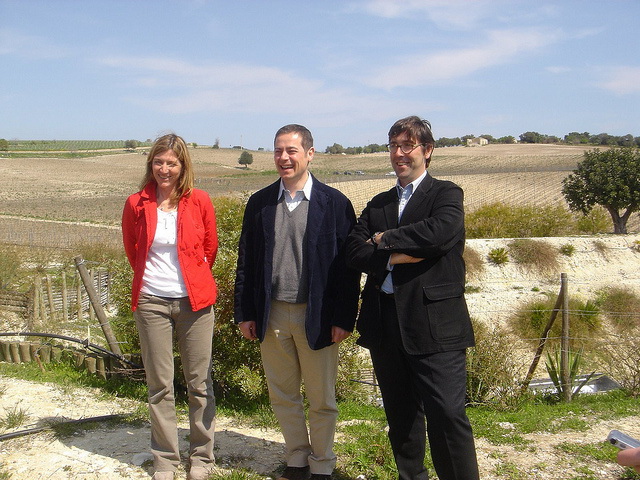 Francesca, Santi and Alessio Planeta
Francesca, Santi and Alessio Planeta
Family is all-important in Sicily: everyone seems suspicious of everyone to whom they’re not related. Did I mention that this is birthplace of the Cosa Nostra? Palermo’s Falcone-Borsellino Airport is named after the two anti-mafia judges who were murdered in 1992.
I’m afraid that’s all I can say.
In 2008, the Planeta family started planting vines on Mount Etna to complete their “rainbow of Sicilian soil colors,” as Alessio says. He believes the black volcanic earth produces wines of unparalleled depth and complexity.
The soil, a mix of slivered rock, pumice, lava and ash, has a low acidity that keeps the grapes’ natural acidity from getting too high. It has many fissures, so it drains well.
Another plus: the root louse phylloxera, which devastated the rest of Europe’s old root stock, can’t survive on volcanic rock, so many vines here are old and ungrafted or as they say, pied frau, which sounds delightfully foot-loose and fancy-free.
So I’ve come to the volcano to taste the wines borne from these fractured rocks and fiery depths. The name Etna comes from the ancient Greek word aitho meaning “I burn.”
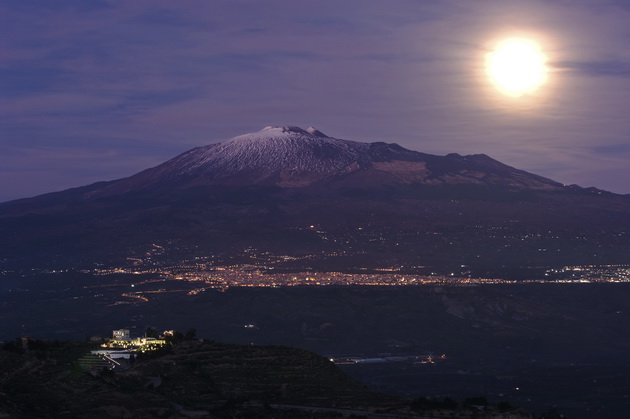 At 3,300 feet above sea level and covering 750 square miles, it’s Europe’s largest and most active volcano—almost three times larger than Vesuvius, which destroyed the city of Pompeii in 79 AD.
At 3,300 feet above sea level and covering 750 square miles, it’s Europe’s largest and most active volcano—almost three times larger than Vesuvius, which destroyed the city of Pompeii in 79 AD.
La Montagna, as the locals reverently call it, is supposedly the home of Vulcan, the Roman god of fire and smithery. The ancient philosopher Empedocles leapt into the crater in 430 BCE to prove he was immortal. (He wasn’t.)
When there’s an eruption, locals say scassau a muntagna (the mountain has broken). A 1669 eruption destroyed the hillside village of Catania and most of its 20,000 inhabitants.
Although the volcano has been fairly quiet since then, just a few decades ago, in 1985, Etna sprayed its fiery discourse across the sea for miles around.
When it hardened, it left a lunar landscape onshore and daggers of black rock piercing the turquoise sea. The lava came proprio vicinissima (really close) to the vineyards.
So far, the solidified rivers of black rock have stopped just a few meters above the vines. In such places, the locals erect white statues of the Madonna, her arms held out from side to side as if to say, “Stop!”
The last major eruption was in 2002, when they closed the Palermo airport for two days of ashfall—islanders used umbrellas when they went outside.
Etna still sends out smoky reminders of her presence, like a whispered “I’m still here.” On this crisp April morning, though, she seems more prim than menacing: a fulsome Victorian lady wearing a snow lace collar above the folds of her black dress.
Continue to Part 2: Volcanic Wine


